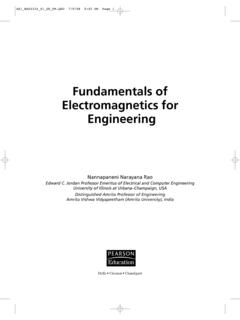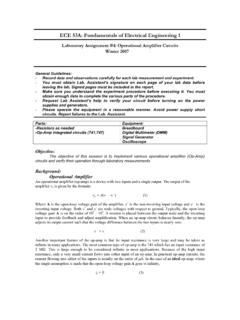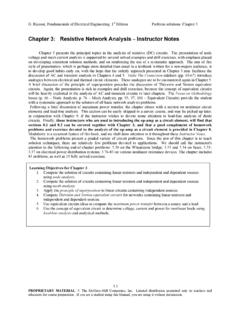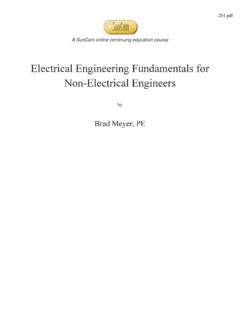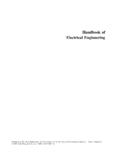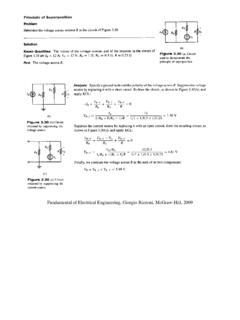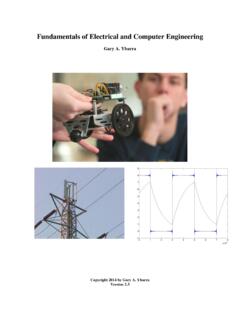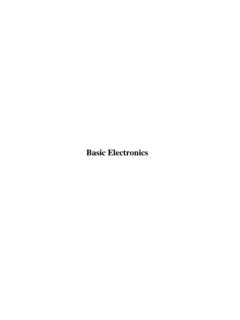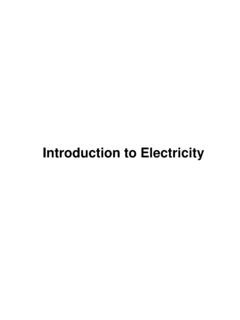Transcription of Fundamentals of Electromagnetics for Electrical …
1 Fundamentals of Electromagnetics for Electrical and computer engineering in 108 Slides: A Tutorial Nannapaneni Narayana Rao Edward C. Jordan Professor of Electrical and computer engineering University of Illinois at Urbana-Champaign, Urbana, Illinois, USA Distinguished Amrita Professor of engineering Amrita Vishwa Vidyapeetham, Ettimadai, Coimbatore, Tamil Nadu, India All Rights Reserved, January 2007 This publication is prepared for use with the presentation of tutorials on the Fundamentals of Electromagnetics by the author.
2 It is not to be sold, reproduced for any purpose other than stated here, or generally distributed. Any use other than as stated here is not authorized and requires the written permission of the author. Om Amriteswaryai Namaha! Om Namah Sivaya! Inscription on wristband from Retreat with Amma Mata Amritanandamayi Devi: Fill your heart with love and then express it in everything you do. In this publication, I have attempted it through 108 slides on the Fundamentals of engineering Electromagnetics . About the Author Nannapaneni Narayana Rao was born in Kakumanu, Guntur District, Andhra Pradesh, India.
3 Prior to going to the United States in 1958, he attended high schools in Pedanandipadu and Nidubrolu; the Presidency College, Madras (now known as Chennai); and the Madras Institute of Technology. He completed high school from Nidubrolu in 1947, received the BSc. Degree in Physics from the University of Madras in 1952, and the Diploma in Electronics from the Madras Institute of Technology in 1955. In the United States, he attended the University of Washington, receiving the MS and PhD degrees in Electrical engineering in 1960 and 1965, respectively.
4 In 1965, he joined the faculty of the Department of Electrical engineering , now the Department of Electrical and computer engineering , of the University of Illinois at Urbana-Champaign, Illinois, serving as Associate Head of the Department from 1987 to 2006. At the University of Illinois at Urbana-Champaign, he carried out research in the general area of radiowave propagation in the ionosphere and authored the undergraduate textbooks, Basic Electromagnetics with Applications (Prentice Hall, 1972), and six editions of Elements of engineering Electromagnetics (Prentice Hall, 1977, 1987, 1991, 1994, 2000, and 2004).
5 The fifth edition of Elements of engineering Electromagnetics was translated into Bahasa Indonesia, the language of Indonesia, by a professor of physics at the Bandung Institute of Technology, Bandung. Professor Rao has received numerous awards and honors for his teaching and curricular activities, and contributions to engineering education in India, the USA, and Indonesia. He received the IEEE Technical Field Award in Undergraduate Teaching in 1994 with the citation, For inspirational teaching of undergraduate students and the development of innovative instructional materials for teaching courses in Electromagnetics .
6 In Fall 2003, Professor Rao was named to be the first recipient of the Edward C. Jordan Professorship in Electrical and computer engineering , created to honor the memory of Professor Jordan, who served as department head for 25 years, and to be held by a member of the faculty of the department who has demonstrated the qualities of Professor Jordan and whose work would best honor the legacy of Professor Jordan. In October 2006, Professor Rao was named the first Distinguished Amrita Professor of engineering by Amrita Vishwa Vidyapeetham, Ettimadai, Coimbatore, Tamil Nadu, India, where, in July August, 2006, he taught the inaugural course on the Indo-US Inter-University Collaborative Initiative on the Amrita e-learning network.
7 A special Indian Edition of Elements of engineering Electromagnetics , Sixth Edition, was published prior to this course offering. Preface .. I am talking about the areas of science and learning that have been at the heart of what we know and what we do, that which has supported and guided us and which is fundamental to our thinking. It is electromagnetism (EM) in all its many forms that has been so basic, that haunts us and guides Nick Holonyak, Jr., John Bardeen Endowed Chair Professor of Electrical and computer engineering and of Physics, University of Illinois at Urbana-Champaign, and the inventor of the semiconductor visible LED, laser, and quantum-well laser, in a Foreword in the Indian Edition of Elements of engineering Electromagnetics , Sixth Edition, by the author.
8 The electromagnetic theory, as we know it, is surely one of the supreme accomplishments of the human intellect, reason enough to study it. But its usefulness in science and engineering makes it an indispensable tool in virtually any area of technology or physical research. George W. Swenson, Jr., Professor Emeritus of Electrical and computer engineering , University of Illinois at Urbana-Champaign, and a pioneer in the field of radio astronomy, in the Why Study Electromagnetics ? Section in the Indian Edition of Elements of engineering Electromagnetics , Sixth Edition, by the author.
9 In this presentation, I present in a nutshell the fundamental aspects of engineering Electromagnetics from the view of looking back in a reflective fashion what has already been learnt in undergraduate Electromagnetics courses as a novice. The first question that comes to mind in this context is: What constitutes the Fundamentals of engineering Electromagnetics ? If the question is posed to several individuals, it is certain that they will come up with sets of topics, not necessarily the same or in the same order, but all containing the topic, Maxwell s Equations, at some point in the list, ranging from the beginning to the end of the list.
10 In most cases, the response is bound to depend on the manner in which the individual was first exposed to the subject. Judging from the contents of the vast collection of undergraduate textbooks on Electromagnetics , there is definitely a heavy tilt toward the traditional, or historical, approach of beginning with statics and culminating in Maxwell s equations, with perhaps an introduction to waves. Primarily to provide a more rewarding understanding and appreciation of the subject matter, and secondarily owing to my own fascination resulting from my own experience as a student, a teacher, and an author over a few decades, I have employed here the approach of beginning with Maxwell s equations and treating the different categories of fields as solutions to Maxwell s equations.
